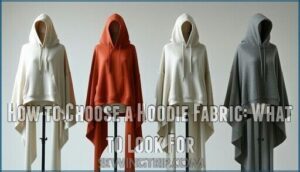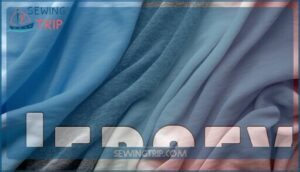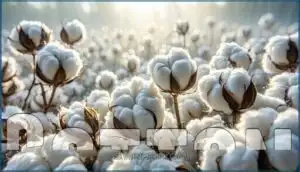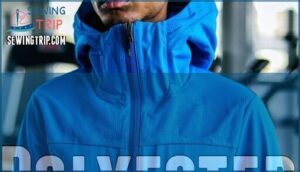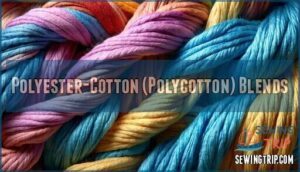This site is supported by our readers. We may earn a commission, at no cost to you, if you purchase through links.

It strikes that perfect balance between warmth and breathability, keeping you cozy without turning you into a walking sauna.
Cotton offers natural softness and breathability, while polyester adds durability and moisture-wicking properties.
Fleece provides excellent insulation, making it ideal for chilly mornings when you need that extra layer of comfort.
Cotton-polyester blends give you the best of both worlds, combining cotton’s comfort with synthetic durability.
The right material depends on whether you prioritize warmth, breathability, or longevity, and understanding these differences can transform your hoodie game completely.
Table Of Contents
- Key Takeaways
- What Materials Are Used for Hoodies?
- What is The Best Fabric Material for a Hoodie?
- How to Choose a Hoodie Fabric: What to Look For
- What to Look for When Buying Fabric for Hoodies
- Best Types of Fabric for Hoodies
- Are Hoodies & Sweatshirts Made Using Special Fabric?
- Can I Use Any Fabric to Make a Hoodie or Sweatshirt?
- Frequently Asked Questions (FAQs)
- Conclusion
Key Takeaways
- Cotton fleece is your top choice – It strikes the perfect balance between warmth and breathability, keeping you cozy without making you overheat like a walking sauna.
- Cotton-polyester blends give you the best of both worlds – You’ll get cotton’s natural comfort and breathability combined with polyester’s durability and moisture-wicking properties.
- Your choice depends on your priorities – If you need maximum warmth, go with fleece; if you want breathability for active wear, choose cotton blends; if durability matters most, pick polyester blends.
- Consider fabric weight and care requirements – Medium-weight fabrics (8-12 oz) offer the best balance, and you’ll want to wash cotton in cold water while polyester blends can handle warmer temperatures.
What Materials Are Used for Hoodies?
Modern hoodies showcase a diverse fabric landscape. You’ll encounter cotton hoodies offering breathability and comfort, polyester hoodies providing durability and moisture-wicking properties, and fleece delivering exceptional warmth.
Fabric blends combine multiple materials’ strengths—cotton-polyester mixes balance softness with resilience. Material weight varies from lightweight jersey to heavy fleece constructions. Weave types include French terry’s looped interior and jersey’s smooth stretch.
Sustainability factors increasingly influence choices, with organic cotton and recycled polyester gaining popularity. Cost analysis reveals blends often provide the best value for hoodie fabric types.
Fleece, known for its superior wind resistance, is a popular choice for colder climates, as seen in this comparison: superior wind resistance.
What is The Best Fabric Material for a Hoodie?
You’ll find that the best hoodie fabric depends on three key factors: warmth, breathability, and durability.
Cotton-polyester blends typically offer the ideal balance, combining cotton’s comfort with polyester’s strength and moisture-wicking properties.
Warmth
When cold weather hits hard, you’ll want fabrics that lock in body heat like a cozy fortress.
The best hoodie for winter combines smart fabric choices with strategic design.
For maximum fleece warmth and comfort, prioritize these features:
- Fabric weight – Heavier materials trap more air for superior insulation
- Wool insulation – Natural fibers regulate temperature while breathing with your body
- Layering hoodies – Double-layer construction creates thermal pockets that hold warm air.
For breathability and comfort, consider cotton’s moisture-wicking properties.
Climate factors matter when choosing your warm hoodie fabric for outdoor adventures.
Breathability
Breathability keeps you comfortable when your hoodie needs to handle moisture and regulate body temperature.
Cotton leads the pack with excellent air permeability and moisture absorption properties. Jersey knits create superior air circulation through their loose weave density, while French terry offers moisture-wicking capabilities without sacrificing comfort.
Lightweight hoodie material enhances breathability by allowing airflow through the fabric. For the best breathable hoodie fabric, look for natural fibers or cotton blends that balance air circulation with fabric weight for everyday wear, providing moisture absorption properties.
Durability
Durability separates hoodies that last from those that don’t.
Polyester blends offer superior fabric strength and abrasion resistance compared to pure cotton.
These strong fabrics resist wear and tear while providing excellent pilling prevention.
Cotton-polyester blends deliver the best of both worlds—comfort plus longevity.
Quality stitch construction matters too, but durable fabric forms your hoodie’s foundation against daily use.
How to Choose a Hoodie Fabric: What to Look For
Smart fabric selection transforms your hoodie from ordinary to extraordinary. When choosing hoodie fabric, you’re basically picking your comfort companion for different seasons and activities.
Consider these key factors during fabric selection:
- Fabric Weight – Light materials work for spring layering, while heavyweight options provide winter warmth
- Intended Use – Athletic activities need moisture-wicking polyester, casual wear benefits from cotton comfort
- Climate Considerations – Hot summers call for breathable cotton blends, cold winters demand insulating fleece
- Personal Preference – Some love cotton’s softness, others prefer polyester’s durability and easy care
Your lifestyle drives the decision. If you’re always on-the-go, polyester fabric blends offer low-maintenance convenience. Homebody types might prefer cotton’s natural breathability.
Budget Impact matters too—cotton costs more upfront but lasts longer with proper care. Test wash samples before committing to larger purchases.
What to Look for When Buying Fabric for Hoodies
When shopping for your hoodie fabric, you’ll want to check several key properties.
First, examine the fabric weight – lighter materials work better for layering, while heavier ones provide more warmth. Look at washing instructions to verify easy care that fits your lifestyle.
Check for pilling resistance, especially if you plan frequent wear. Color fastness matters too; nobody wants a hoodie that fades after a few washes.
Don’t forget the shrinkage rate – pre-shrunk fabrics save you from size surprises. Understanding fabric weight options is vital for selecting the right material.
These fabric properties determine whether you’ll get comfortable hoodie material that stays durable hoodie fabric for years.
Best Types of Fabric for Hoodies
When you’re choosing fabric for your hoodie, you’ll want to examine five main types that offer different benefits for comfort and performance.
Each fabric type has specific strengths, from fleece’s warmth retention to cotton’s breathability, so understanding these differences helps you pick the right material for your needs.
Fleece
Looking for the softest hoodie material? Fleece fabric is your go-to for warmth and comfort. It’s lightweight yet insulating, perfect for chilly days.
Plus, fleece hoodies are breathable, moisture-wicking, and built to last with excellent pilling resistance. Durable materials guarantee longevity, making them ideal for outdoor activities.
- Keeps you warm without bulk
- Feels like a cozy hug
- Dries quickly after washing
- Stays durable through wear
- Perfect for layering or lounging
Jersey
The jersey knit stands out as your go-to choice for flexible, comfortable hoodies.
This stretchy fabric moves with your body while maintaining its shape, making it perfect for active lifestyles.
Cotton jersey offers breathability and softness, while jersey blends add durability.
The jersey weave creates a smooth surface that’s ideal for printing designs.
Jersey weight varies from lightweight to medium, giving you options for different seasons.
One of its advantages is that it’s lightweight and breathable, making it ideal for various activities.
Key benefits of jersey comfort include:
- Smooth texture that feels great against your skin
- Great elasticity for unrestricted movement
- Easy care with machine-washable convenience
- Lightweight feel perfect for layering
- Versatility across different knit fabrics and blends
Cotton
Cotton hoodies deliver unmatched comfort through natural fiber breathability and moisture-wicking properties.
Cotton softness makes them perfect for everyday wear, while cotton durability guarantees longevity through countless washes.
Whether you choose 100 cotton for pure comfort or cotton blends for enhanced performance, organic cotton options provide eco-friendly benefits without sacrificing quality.
For a truly luxurious feel, consider options where long fibers enhance the material’s softness.
| Cotton Type | Benefits | Best For |
|---|---|---|
| 100% Cotton | Maximum softness, breathability | Casual wear, sensitive skin |
| Cotton Blends | Enhanced durability, shape retention | Active lifestyle, frequent washing |
| Organic Cotton | Eco-friendly, chemical-free | Sustainable fashion, allergy-prone users |
Cotton hoodies are suitable for various needs, including casual wear, active lifestyle, and sustainable fashion, making them a versatile choice for many users.
The benefits of each cotton type, such as maximum softness and enhanced durability, cater to different preferences and requirements.
Polyester
You can’t go wrong choosing polyester for your next hoodie purchase.
This synthetic fiber delivers unmatched polyester durability that withstands countless washes without losing shape or color. Athletes especially appreciate polyester’s moisture-wicking properties, which keep you dry during intense workouts.
Here’s why polyester hoodies excel:
- Superior moisture wicking keeps sweat away from your skin
- Athletic performance benefits from lightweight, breathable fabric
- Cost effectiveness offers premium features at budget-friendly prices
- Wrinkle resistance means less ironing and maintenance
- Quick-drying synthetic fibers save time on laundry day
A polyester hoodie won’t shrink, fade, or stretch out of shape. Consider hoodie material longevity for sustained use. While it may feel less cozy than cotton initially, modern polyester blends have improved substantially in comfort and softness.
Polyester-Cotton (Polycotton) Blends
Polycotton blends deliver the perfect marriage of comfort and durability.
You’ll get cotton’s breathability plus polyester’s strength in one fabric.
These cotton-polyester combinations resist shrinkage and pilling better than pure cotton while staying softer than straight polyester.
One benefit of these blends is their ability to actively wick away sweat.
| Feature | Cotton Blend Benefit | Polyester Blend Advantage |
|---|---|---|
| Durability | Natural comfort | Superior strength |
| Care | Easy washing | Wrinkle resistance |
| Cost | Affordable option | Budget-friendly |
Are Hoodies & Sweatshirts Made Using Special Fabric?
In the context of fabric construction, hoodies and sweatshirts don’t require completely unique materials, but they do benefit from specific design features.
Unlike regular t-shirts, these garments use knitted fabrics with special loops on the interior surface that trap air for insulation.
The best materials like fleece, cotton, and polyester are engineered with precise blend ratios to optimize performance features such as warmth retention and moisture management.
Material sourcing focuses on fabrics that can handle the structural demands of hoodies—supporting hoods, pockets, and drawstrings without stretching out.
French terry and jersey knits are popular choices because their fabric construction provides the right balance of stretch and stability.
While sustainability factors increasingly influence manufacturing, the core requirement remains the same: fabrics must offer durability, comfort, and thermal properties that make hoodies functional for their intended purpose.
Can I Use Any Fabric to Make a Hoodie or Sweatshirt?
You can technically use any fabric to make hoodies, but fabric limitations play a vital role in your project’s success.
While basic sewing skills open doors to creativity, certain materials work better than others depending on your intended use and skill level.
The best hoodie material depends on your specific needs:
- Cotton blends offer breathability and comfort for everyday wear
- Fleece fabrics provide warmth but require experience with stretch materials
- Jersey knits drape well but need proper handling techniques
- Polyester blends resist wrinkles but may feel less comfortable.
Cost considerations matter too—premium fabrics like merino wool cost more but deliver superior results.
Finding the ideal hoodie material can greatly improve comfort and durability.
For beginners, stick with proven hoodie materials like cotton-poly blends. They’re forgiving, affordable, and create hoodies that actually feel like the ones you’d buy in stores.
Frequently Asked Questions (FAQs)
What is the best material for hoodies?
Like finding your perfect companion, you’ll want cotton-polyester blends for hoodies.
They’re your sweet spot—combining cotton’s breathability with polyester’s durability.
You get comfort, moisture-wicking, and longevity in one cozy package.
Should hoodies be 100% cotton?
You shouldn’t choose 100% cotton hoodies if you want durability and shape retention.
Pure cotton shrinks, wrinkles easily, and lacks stretch.
Cotton-polyester blends offer better performance, combining cotton’s comfort with polyester’s resilience.
What are luxury hoodies made of?
Luxury hoodies typically feature premium materials like cashmere, merino wool, high-grade cotton, or silk blends.
You’ll find superior construction with reinforced seams, quality hardware, and often organic or sustainably sourced fabrics for enhanced comfort and durability.
Is a 100% polyester hoodie good?
A 100% polyester hoodie offers excellent durability and moisture-wicking for workouts, but you’ll sacrifice breathability and comfort. It’s budget-friendly but may feel less cozy than cotton blends for everyday casual wear.
How do I care for and wash different hoodie fabrics?
You’ll want to wash cotton hoodies in cold water and air dry them to prevent shrinking.
For fleece, use gentle cycles with fabric softener.
Polyester blends handle warm water well, while delicate fabrics need cold water and low heat.
How do you wash different hoodie fabrics?
Cotton hoodies need cold water and gentle cycles to prevent shrinkage.
Fleece requires low heat drying to maintain softness.
Polyester blends handle warm water well.
Always turn hoodies inside-out before washing to protect prints and colors.
What fabric weight is best for hoodies?
Finding your hoodie’s sweet spot is like Goldilocks choosing porridge—not too heavy, not too light.
Medium-weight fabrics (8-12 oz) offer perfect balance.
You’ll stay cozy without overheating, whether lounging at home or heading out, with a medium-weight fabric.
Do organic cotton hoodies perform differently?
Organic cotton hoodies breathe just like regular cotton but they’re gentler on your skin and the planet.
You’ll get the same moisture-wicking comfort without harsh chemicals or synthetic treatments affecting performance.
Which fabrics cause pilling in hoodies?
Around 78% of hoodie owners experience pilling within six months.
You’ll find cotton-polyester blends and pure cotton cause the most pilling due to shorter fibers rubbing together.
Fleece and high-quality cotton blends resist pilling better.
Are bamboo hoodies worth the extra cost?
Bamboo hoodies offer superior softness, moisture-wicking, and antibacterial properties compared to cotton.
You’ll pay 20-40% more, but they’re worth it if you value comfort, odor resistance, and eco-friendly materials for everyday wear.
Conclusion
Choosing the best material for hoodies doesn’t require a PhD in textile engineering, though some people act like it does.
You’ve learned that cotton fleece offers superior comfort and breathability, while polyester blends provide durability and moisture-wicking properties.
Consider your priorities: warmth for winter wear, breathability for active use, or longevity for everyday comfort.
Whether you select pure cotton, fleece, or blends, understanding fabric properties guarantees you’ll find the perfect hoodie that matches your lifestyle and climate needs.


